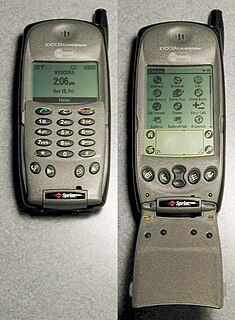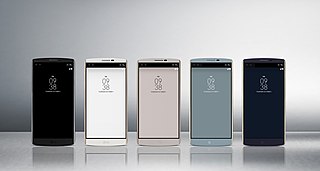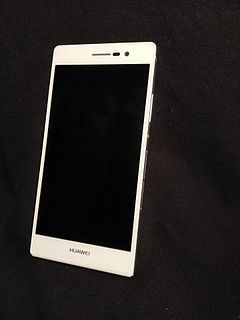
A smartphone is a mobile device that combines cellular and mobile computing functions into one unit. They are distinguished from feature phones by their stronger hardware capabilities and extensive mobile operating systems, which facilitate wider software, internet, and multimedia functionality, alongside core phone functions such as voice calls and text messaging. Smartphones typically contain a number of metal–oxide–semiconductor (MOS) integrated circuit (IC) chips, include various sensors that can be leveraged by their software, and support wireless communications protocols.
Kona or KONA may refer to:

Maxthon is a freeware web browser developed by the company Maxthon Ltd., based in Beijing, China. It is available for Windows, macOS, Linux, and as Maxthon Mobile for Android, iOS, and Windows Phone 8. As of version 3, Maxthon supports two web browser engines: WebKit and Trident.

The J-SH04 was a mobile phone made by Sharp Corporation and released by J-Phone. It was only available in Japan, and was released in November 2000. It was Japan's first phone with a built-in, back-facing camera. It has a 110,000 pixel CMOS image sensor and a 256 color display. The phone weights 74g, and its dimensions are 127 × 39 × 17 mm. It was succeeded by the J-SH05 flip phone, which was released just one month later.

The Kyocera 6035 was one of the first smartphones to appear in the American market, released in January 2001, one of the first devices to combine a PDA with a mobile phone. Its predecessor was the Qualcomm pdQ released in 1999, built by Qualcomm's handset division, which Kyocera acquired in 2000.

Helio, Inc. is a former, mobile virtual network operator (MVNO) using Sprint's network that offered wireless voice, messaging and data products and services to customers in the continental United States beginning on May 2, 2006. Originally a 50/50 joint venture founded in January, 2005 between South Korean wireless operator SK Telecom and American Internet services provider EarthLink, early losses caused EarthLink to stop providing additional funding in fall of 2007. SK Telecom provided the required additional funding to sustain Helio, which was re-organized as Helio LLC, and by January 2008, SK Telecom had assumed an increased ownership stake and with it, operational control of the joint venture. Although SK Telecom publicly pledged to support Helio, SK Telecom entered into talks to sell the company to rival MVNO Virgin Mobile USA. Virgin Mobile USA closed the acquisition of Helio and its 170,000 subscribers on August 22, 2008. Virgin Mobile USA exited the postpaid wireless business and retired the Helio brand on May 25, 2010.

Bing for mobile is a search tool for handheld mobile devices from Microsoft as part of their Bing search engine. It is designed for mobile device displays. Bing Mobile is built into Windows Mobile and Windows Phone as proprietary software, accessed via the Search key on Windows Phone 7 and Windows Phone 8 devices. It is also available on Windows Phone 8.1, and can be downloaded for other platforms, including iOS and Android.
The form factor of a mobile phone is its size, shape, and style, as well as the layout and position of its major components.

Kin was a short-lived mobile phone line from Microsoft designed for users of social networking. Microsoft described the phones' target demographic as men and women between ages 15 and 30. It was manufactured by Sharp Corporation and sold through Verizon Wireless.

The Samsung SPH-i300 was an early Palm OS-based smartphone manufactured by Samsung. It was released around 2001. It was marketed in the United States for use on Sprint's mobile phone network. It was the first "PDA phone" in the US with a color screen.
The Kyocera Zio is an Internet-enabled 3G smartphone manufactured by Kyocera, running Google's Android operating system.

Dolphin Browser is a web browser for the Android and iOS operating systems developed by MoboTap. It was one of the first alternative browsers for the Android platform that introduced support for multi-touch gestures. Dolphin Browser uses its native platform's default browser engine, which allows for a small disk footprint. It can also run Adobe Flash on Android.

The Samsung Galaxy Young is a low-end smartphone by Samsung Electronics which was released in March 2013. Like all other Samsung Galaxy smartphones, the Galaxy Young runs on the Android mobile operating system. The phone features a 3.27 inch TFT LCD touchscreen. The phone has Dual SIM capabilities depending on the model. Many users have found the device's capabilities basic, seeing it as a low-end smartphone for children or teenagers who are having their first smartphone as the name implies.

Nexus 5 is an Android smartphone manufactured by LG Electronics for Google. Co-developed with and marketed by Google Inc. as part of its Nexus line of flagship devices and unveiled on October 31, 2013, the Nexus 5 served as the launch device for Android 4.4 "KitKat", which introduced a refreshed interface, performance improvements, increased Google Now integration, better battery life and other features.

Moto E is an Android smartphone developed and manufactured by Motorola Mobility. It was unveiled and released online in India and the United States on May 13, 2014.

The LG V10 is an Android smartphone manufactured by LG Electronics as part of the LG V series. Announced in September 2015 and released in October 2015, the device shares many similarities with the earlier LG G4. Its main feature is a customizable second display above the primary display, which, among other uses, shows notifications and music controls without waking up the primary display. In 2016, its successor, the LG V20 was released.

The Huawei Ascend P7 is a high-end smartphone by Huawei running the Android operating system. It was announced in May 2014 and released in June 2014. It received mixed to positive reviews, with most critics noting the slim glass construction, good front camera quality, and slow processor.

Foldable smartphones are a family of smartphone form factors utilizing hinged flexible displays. Devices whose displays fold on a vertical axis are designed to fold out into a wider, tablet-like form, but are still usable in a smaller, folded state; the display may either wrap around to the back of the device when folded, or use a booklet-like design where the larger, folded screen is located on the interior, and a screen on its "cover" allows the user to interact with the device without opening it. Horizontally-folding smartphones have also been produced, typically using a clamshell form factor.

The LG G8 ThinQ is an Android smartphone developed by LG Electronics as part of the LG G series. It was officially announced on February 24, 2019. The device serves as the successor to the 2018 LG G7 ThinQ.

The OnePlus 7 and 7 Pro are Android smartphones manufactured by OnePlus. They were unveiled on 14 May 2019.
















